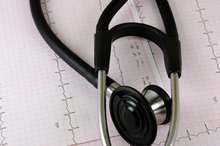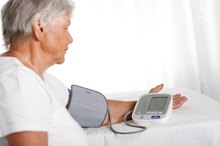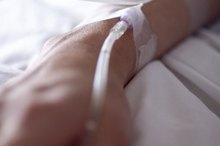What does fact checked mean?
At Healthfully, we strive to deliver objective content that is accurate and up-to-date. Our team periodically reviews articles in order to ensure content quality. The sources cited below consist of evidence from peer-reviewed journals, prominent medical organizations, academic associations, and government data.
The information contained on this site is for informational purposes only, and should not be used as a substitute for the advice of a professional health care provider. Please check with the appropriate physician regarding health questions and concerns. Although we strive to deliver accurate and up-to-date information, no guarantee to that effect is made.
What Tools Does a Doctor Use?
During your physical exam your doctor makes use of several different doctor's tools such as a blood pressure monitor which is designed to measure your blood pressure; an ophthalmoscope which is used to examine the eyes; a thermometer which the doctor will use to measure your temperature; a stethoscope which a doctor uses to listen to the patient's heart, lungs and abdomen, and an otoscope which your doctor will use to examine the inside of your ears, nose and mouth 2.
If you are experiencing serious medical symptoms, seek emergency treatment immediately.
In addition to these, there are many more doctor's tools that are used in different specialized areas of medicine, to diagnose and observe and monitor a variety of more complicated medical conditions.
Stethoscope
This doctor's tool is a major symbol of the medical profession. Its beginnings can be traced all the way back to Laennec, the French doctor, who was the inventor of a crude model in 1819. Many modifications have occurred since then. The original version consisted of a wooden box in which the doctor heard the sounds within the patient's chest cavity.
The modern version is composed of two earpieces that are connected by a piece of flexible tubing to a diaphragm. A doctor makes use of this tool when he wants to hear the low-volume sounds that are put out by the heart, intestine and the fetal heartbeat.
- This doctor's tool is a major symbol of the medical profession.
- The original version consisted of a wooden box in which the doctor heard the sounds within the patient's chest cavity.
Otoscope
Medical Instruments & Their Uses
Learn More
An otoscope is another commonly used tool in health exams. It has a cone-shaped attachment on the end called an ear speculum. It is used to examine a patient's ear canal. The doctor is able to peer into the ear canal in order to check whether the eardrum is red or has fluid behind it; this is indicative of an ear infection. A pneumatic otoscope delivers a small puff of air to a patient's eardrum to see if it vibrates. This vibration of the eardrum is completely normal. An otoscope examination can also detect a wax build-up in the ear canal or whether the eardrum is punctured or ruptured.
- An otoscope is another commonly used tool in health exams.
- A pneumatic otoscope delivers a small puff of air to a patient's eardrum to see if it vibrates.
Blood Pressure Monitor
Measuring blood pressure calls for an instrument named sphygmomanometer which measures the blood pressure in the arteries. There are basically two types of these instruments. One kind is a mercury column and the other consists of a gauge accompanied with a dial face. The sphygmomanometer which is most commonly used today is the gauge which is attached to a rubber cuff. It is then wrapped around the patient's upper arm and is inflated in order to constrict the arteries. When the cuff is fully inflated with air, the doctor places a stethoscope over the brachial artery in the crook of the patient's arm. As the air in the cuff is slowly released, the first sound the doctor hears through the stethoscope is the systolic pressure. As the air continues to be released from the cuff, another point is reached when the doctor no longer hears any sound. This marks the diastolic blood pressure.
- Measuring blood pressure calls for an instrument named sphygmomanometer which measures the blood pressure in the arteries.
- As the air in the cuff is slowly released, the first sound the doctor hears through the stethoscope is the systolic pressure.
Thermometer
Medical Instruments & Their Uses
Learn More
A thermometer is one of the most commonly used tools by doctors. It is a doctor's tool that measures the body temperature. They come in the following types:
Oral and rectal thermometers: A conventional oral or rectal thermometer consists of a sealed glass tube containing a liquid like mercury. Imprinted on the tube is a temperature scale. When the temperature rises or falls, the mercury will expand or contract, causing the mercury to move up or down the thermometer's tiny passageway. If the mercury moves up the scale, before it is used again, the thermometer will have to be “shaken down.” In order to get an accurate reading, the patient must keep this instrument in contact with her body for approximately four minutes in order to obtain an accurate reading. The rectal thermometer is typically a little more accurate than an oral thermometer.
Digital thermometers: Today thermometers are available that have digital displays. It is much easier to read the temperature this way. A beeper signals when the thermometer has finished registering the temperature. These thermometers come with flexible tubes that resist breakage.
Ear thermometers: Eardrum thermometers are very precise and read infrared radiation that emanates from the eardrum tissue.
Basal thermometers: These thermometers measure minor changes in temperature in a woman's body to indicate to her whether ovulation, or when an egg has been released from a woman's ovary, has taken place. A woman's temperature may rise slightly when ovulation occurs and will not return to a normal temperature until the beginning ogf menstruation. Basal thermometers are quite sensitive and will monitor even the slightest temperature change.
- A thermometer is one of the most commonly used tools by doctors.
- If the mercury moves up the scale, before it is used again, the thermometer will have to be “shaken down.”
Ophthalmoscope
One very important tool used by a doctor is an ophthalmoscope, which examines the interior portion of the eye including the retina, optic nerve and lens 2.
A common clinical ophthalmoscope, which can be found in your family physician's office, consists of a concave mirror along with a battery-powered light that is housed within the handle 2. The doctor peers through one monocular eyepiece into each eye of the patient. This tool has been developed with a rotating disc of lenses which permits the eye to be examined at different magnifications and depths. For a doctor to use this tool efficiently, a patient may have to have eye drops that will dilate the pupil as well as enlarge the opening into the eye's inner structures.
The ophthalmoscope has been an invaluable tool in many medical fields including cardiology, hematology, genetics, neurosurgery, family medicine, internal medicine, diabetes, medical genetics, rheumatology, neurology, pediatrics and geriatrics 2.
- One very important tool used by a doctor is an ophthalmoscope, which examines the interior portion of the eye including the retina, optic nerve and lens 2.
- A common clinical ophthalmoscope, which can be found in your family physician's office, consists of a concave mirror along with a battery-powered light that is housed within the handle 2.
Related Articles
References
- WD: What does your doctor do in a physical examination?
- MedicineNet.com: Ophthalmoscope
- MayoClinic.com: Eye Exam
- MedicineNet.com: Definition of a Stethoscope
- MedicineNet.com: Definition of Thermometer
- Sulaski Wyckoff A. Thermometer use 101. AAP News. 2009;30(11);29. doi:10.1542/aapnews.20093011-29a
- El-Radhi AS. Determining fever in children: the search for an ideal thermometer. Br J Nurs. 2014;23(2):91-94. doi:10.12968/bjon.2014.23.2.91
- Geijer H, Udumyan R, Lohse G, Nilsagård Y. Temperature measurements with a temporal scanner: systematic review and meta-analysis. BMJ Open. 2016;6(3):e009509. doi:10.1136/bmjopen-2015-009509
- U.S. Environmental Protection Agency. Mercury thermometers. Updated June 26, 2018.
- Stanford Children's Health, Lucile Packard Children's Hospital. Fever in children.
- American Academy of Pediatrics: healthychildren.org. How to take a child's temperature. Updated November 21, 2015.
- Obermeyer Z, Samra JK, Mullainathan S. Individual differences in normal body temperature: longitudinal big data analysis of patient records. BMJ. 2017;359:j5468. doi:10.1136/bmj.j5468
Writer Bio
Based in the Midwest, Valli Schieltz has been freelance writing for the Web since 2006. She has had articles published on eHow and loves to write about subjects dealing with medicine. She has also taught English and language arts classes to junior high school students. She attended Notre Dame College in Ohio.








